Product Research Pulse is an app developed by Algopix that helps ecommerce sellers analyze products online to find high-demand, low-competition, profitable opportunities.
It allows you to search for and assess products individually or in bulk, analyze specific stores on channels like Amazon, eBay and Walmart, convert product identifiers and track selected products & competitors to keep on top of changes in the market.
The Benefits of Product Research Pulse
Product Research Pulse is a comprehensive tool that enables ecommerce merchants, brands and analysts to optimize operations, enhance decision-making and ultimately increase profitability.
Its many benefits include the ability to:
- Analyze price lists from suppliers
- Analyze competitor product assortment
- Optimize sales channels and prices for greater profit margins
- Strategize market entry for new products
- Improve demand forecasting and inventory management
- Enhance product research and development
- Improve product content to match consumer search patterns
Product Research Pulse adds data-backed decision-making to the toolkit of ecommerce sellers to allow them to better align with market dynamics, consumer behaviors and competitive landscapes.
Unique offerings like ‘Multi Product Analysis’ and the ‘Identifier Converter’ mean users can quickly assess what to sell, where and at what price point, with seamless cross-platform product identification to boot.
Pricing and Limits
Product Research Pulse is available on a 7-day free trial and costs $9.99 per month thereafter. A promotional price of $2.99 per month is currently available.
Usage limits are as follows:
- Identifier Converter: 10,000 products per month
- Single Product Analysis: 1,000 products per day
- Multi Product Analysis: 100 searches per day and 3,000 items per file
- Amazon Store Analysis: 50 searches per day and more than 2,400 products per search
- Identify By Keywords: 50 searches per day
- Track Products: 1,000 products and 100 groups
- Sales Estimator - Amazon US: No limit
How To Use Product Research Pulse
Product Research Pulse can be an invaluable resource for anyone involved in ecommerce, from individual sellers and small-to-medium-sized businesses (SMBs) to large brands and marketing agencies. The vast amounts of data and time-saving automation features make it as useful for demand forecasting as it is for content planning.
There are three main categories of solutions available in Product Research Pulse:
- Analyze
- Single Product Analysis
- Multi Product Analysis
- Store Analysis
- Sales Estimator
- Discover
- Identify By Keywords
- Product Matching
- Identifier Converter
- Track
- Track Products
Hover over ‘Solutions’ in the main navigation bar to reveal short descriptions of each product and click on each title to go to that solution.
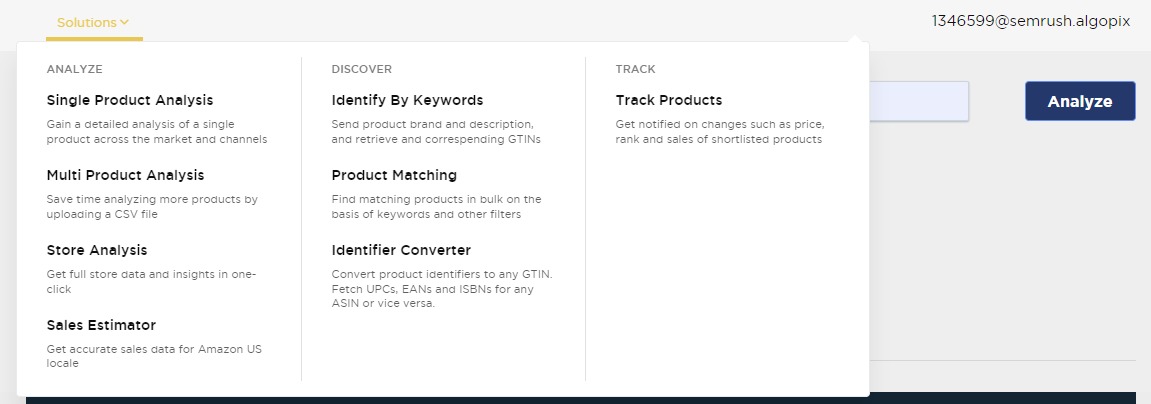
Single Product Analysis
There are a few different ways to search for an individual product in Product Research Pulse, with a range of filters to help you narrow your search.

You can start with a keyword or the product identifier, such as the GTIN (Global Trade Item Number), which can be 8, 12, 13 or 14 digits long. This number can include other identifiers, such as the:
- UPC (Universal Product Code): This barcode consists of 12 numbers that are uniquely assigned to each product. The UPC is widely used in the United States, Canada, United Kingdom, Australia, New Zealand and Europe.
- EAN (European Article Number): This barcode consists of 13 numbers that are uniquely assigned to each product. The EAN is widely used in Europe.
- ISBN (International Standard Book Number): An ISBN is assigned to each edition and variation (except re-printings) of books. The ISBN is 13 digits long if assigned on or after 1 January 2007 and 10 digits long if assigned before 2007.
Products specific to Amazon will include an ASIN (Amazon Standard Identification Number). The ASIN consists of 10 alphanumeric characters assigned by Amazon.com and its partners for product identification within the Amazon organization.
For the example below, we’ll enter the EAN for a toothbrush sold on eBay in Europe. Here, you can set your purchase price, which may have been either quoted by a supplier or previously paid in an existing inventory, as well as your desired price range.

The minimum and maximum price range parameters are only relevant when searching by keywords instead of UPC, EAN or ASIN identifiers. It’s not mandatory to set a price range, but it can help the algorithm find better matches if you choose to search in this way.
Once you’ve added the filters you want to use, you can then select your marketplaces, which currently include Amazon, eBay and Walmart—for this example, we’ll deselect all the markets outside Europe on account of the EAN:
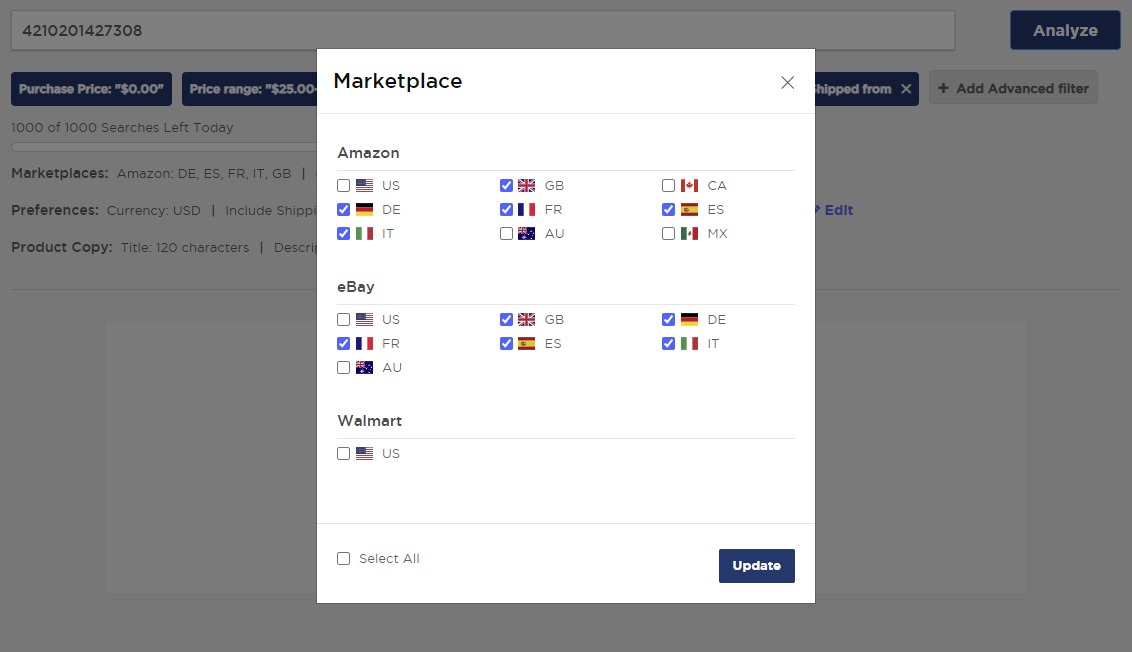
Next, you can set your preferences for currency, shipping costs, taxes and Google AdWords for your product report. Please note that currency code is a required parameter if either of the minimum or maximum price parameters above are used.
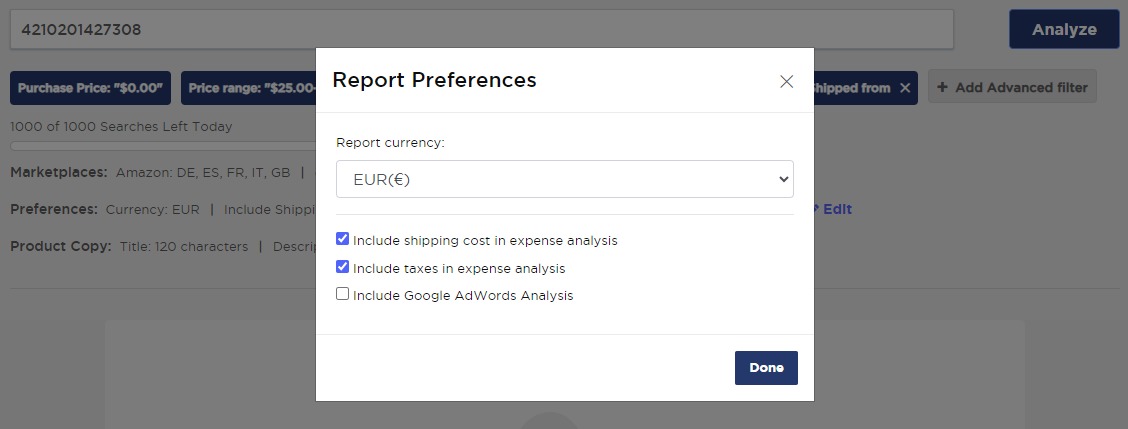
If you select a different currency to the default (USD$), you will be prompted to confirm that you want your purchase currency to be the same as your results currency—in this case, EUR€:

Before you proceed to analyze your chosen product, you can define the product copy parameters to guide the AI for your own potential listings (the AI will generate copy suggestions for you). Set your desired length of title, description and bullet-pointed list using the yellow sliders in the pop-up box and click ‘Done’:
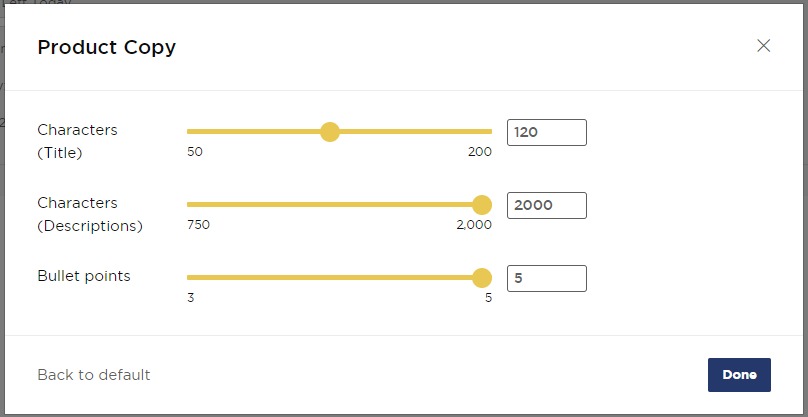
When you’re happy with your selections, click ‘Analyze’ to the right of the product identifier box:

You will then be presented with your results, which will include a range of details to help you decide whether or not to take on the product in any given market.
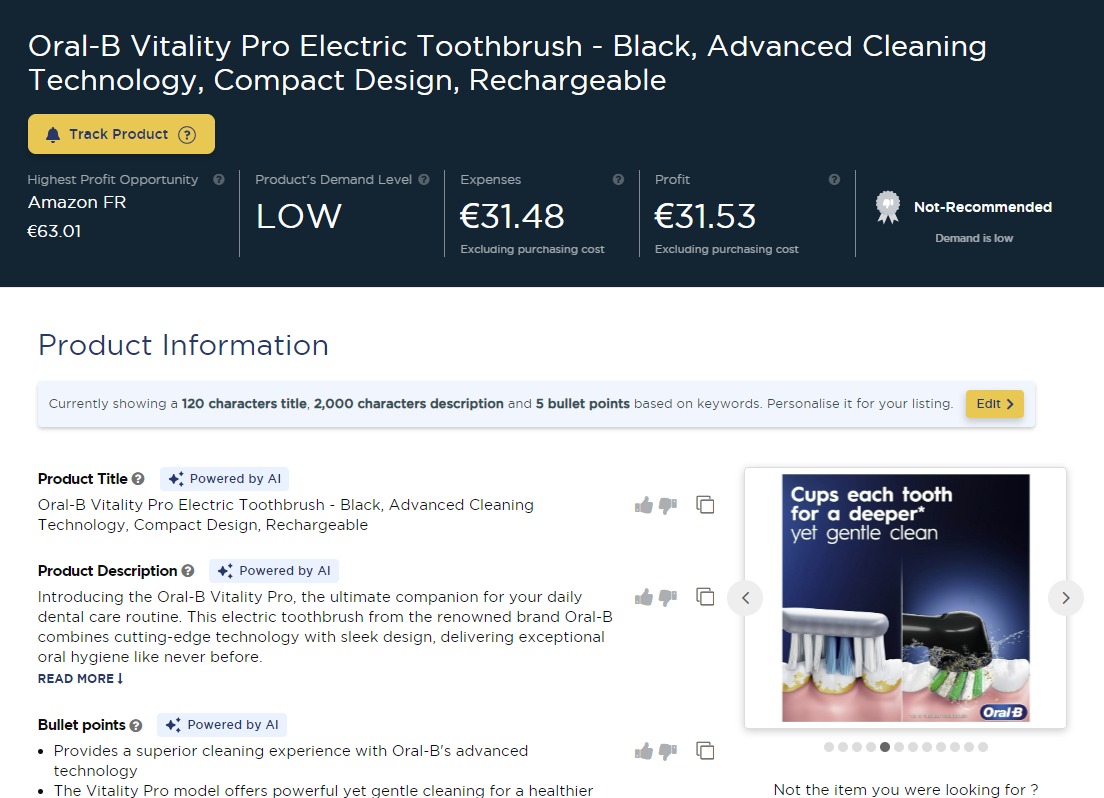
The summary at the top of the page will include:
- Highest Profit Opportunity: Calculated using a simple price-minus-cost model, this takes into account all the fees associated with selling a product, such as purchase price, shipping cost and taxes, and subtracts them from the current product price in a given channel—the ‘Highest Profit Opportunity’ indicates the highest possible margin based on these estimations
- Product’s Demand Level: The demand level of your chosen product, determined by organic search volume and product sales estimates across the selected markets—the value returned will be ‘High,’ ‘Medium’ or ‘Low’
- Expenses: The calculated expenditure that comes with your chosen product, including shipping costs, marketplace fees, PayPal fees, taxes and the purchasing cost (the latter two are not included if you opt to filter them out in the previous step)
- Profit: The profit after all expenses, which is typically the Highest Profit Opportunity figure minus the Expenses figure
- Recommended or Not Recommended: This indicates whether or not the product is a good match for your market(s)—the algorithm will recommend a product for sale here based on a demand level of either ‘Medium’ or ‘High’ and a profit margin of at least 15% according to the purchase price and associated costs
- ‘Track Product’ option: Clicking the yellow ‘Track Product’ button underneath the main title adds the selected product to your list in the ‘Track’ section of the app, meaning you’ll be able to monitor changes in price, sales or rankings at your convenience
The ‘Product Information’ section that follows will include the AI-generated title, description and bullet points for your selected product, written to the lengths you specified in the previous step.
You can edit those criteria by clicking the yellow ‘Edit’ button in the top-right, while you can vote them up or down with the thumb icons to the right of each text. If you like what you see, you can copy the text straight to your clipboard to use on your chosen channels.

You will also see a gallery of images collected via listings that match the product ID you entered and some additional details, such as the dimensions of the product and the packaging for shipping. The dimensions are obtained from the app’s proprietary database, which contains a catalog of 1B+ products.
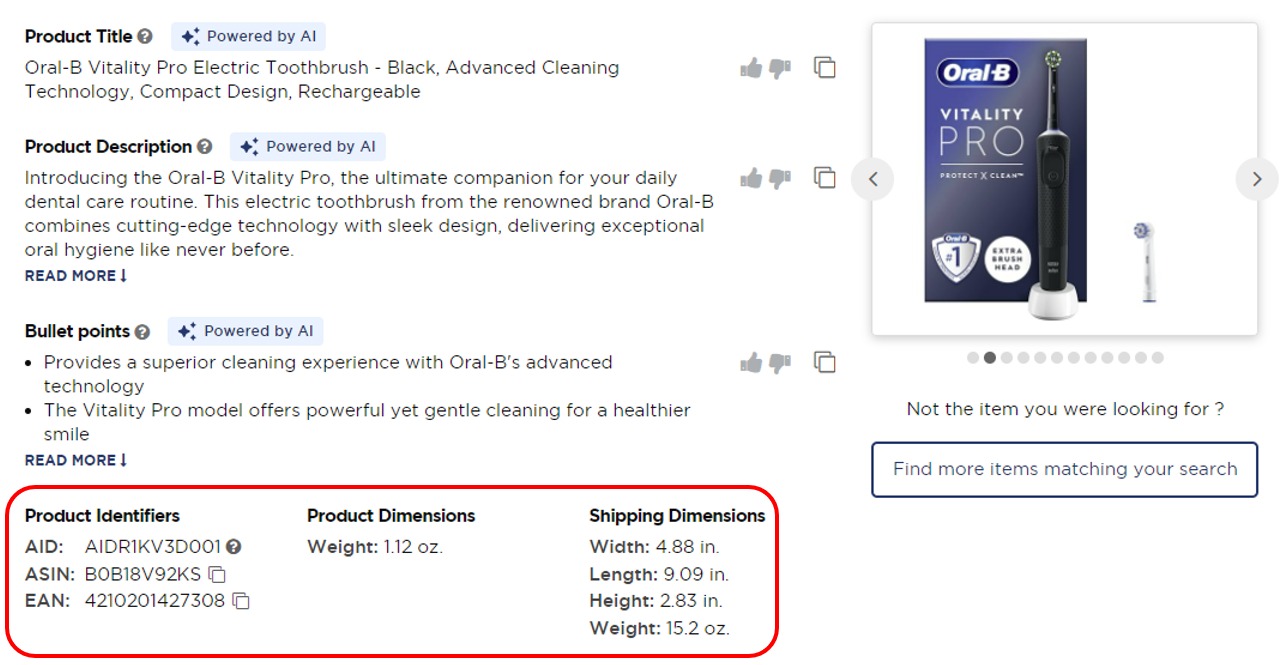
The app also analyzes the product attributes across listings in the selected markets and presents a coverage indicator to show you how common they are—AI will also generate additional attributes that you can use in your own listings if you proceed with the product, but be sure to check for any inaccuracies before you do:
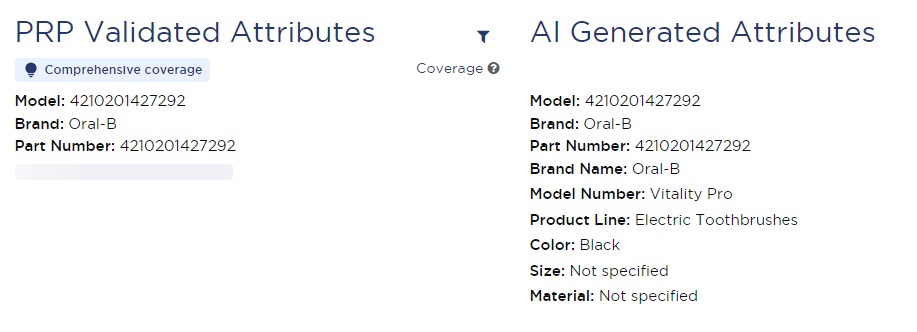
Next, you’ll see the table of product insights from the markets you selected. This will include the market prices, the estimated expenses and profit, an indication of competition and demand and a personal recommendation for your channels.
You will also get Algopix Listing Insights in the right-hand column to give you extra information about how the app determines its recommendations—hover over each of the icons for their names.
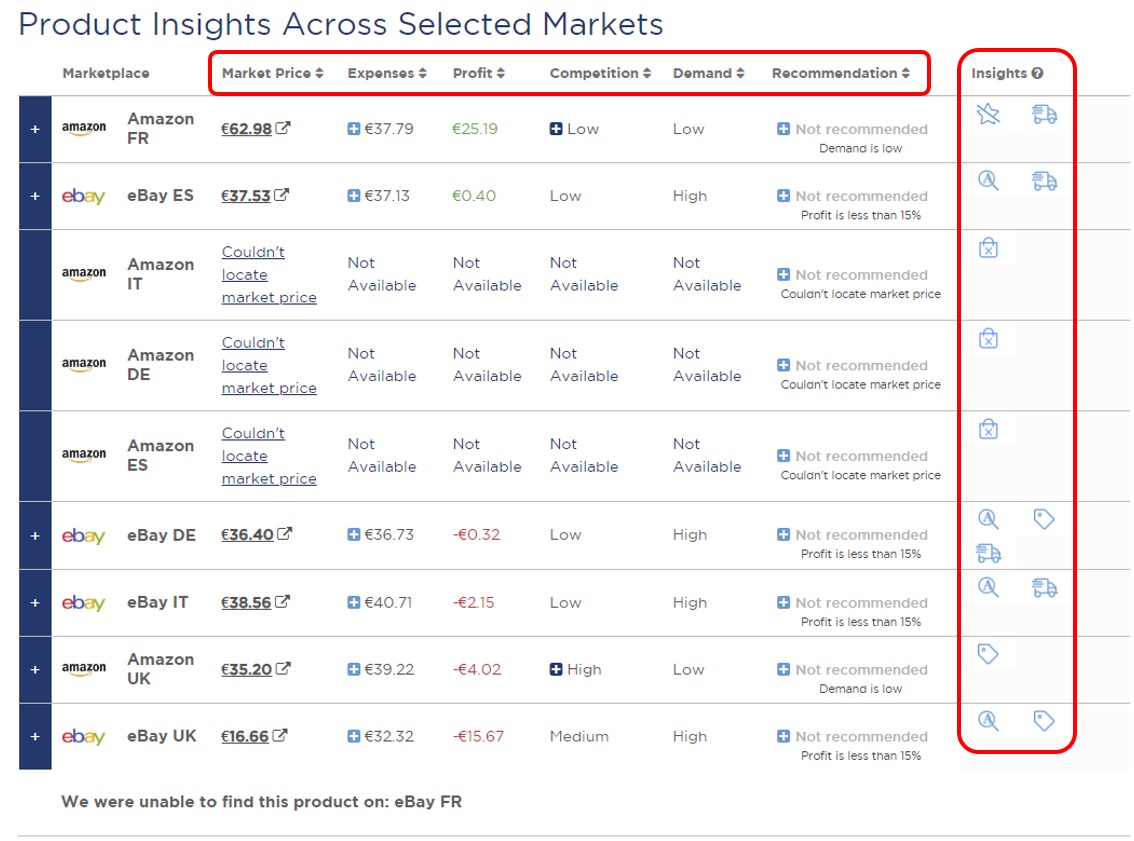
These insights include:
- Displaying lowest price from a high-ranked seller: When viewing the product in the marketplace, you might find an offering for a lower price from a seller with a low feedback score or a low number of ratings. This offer is excluded because it is not deemed to be direct competition.
- Cross-channel competition: Although the product is recommended in a given channel, you may notice that it is offered on another channel in the same country for a lower price. This means users who compare prices may decide to purchase the product on another channel from a different seller.
- Listed by a low-ranked seller: This listing is sold by a seller with less than 90% positive feedback or fewer than 100 ratings. It is the best alternative customers have in this channel, since there are no current listings sold by professional sellers. It might represent a price lower than the actual market price and the seller probably has limited quantity and can, therefore, risk low margins.
- Listing identified using keywords: This listing was identified using keywords and not barcodes. Please validate manually before sourcing this product.
- Listing price includes shipping: The displayed price includes the shipping costs as specified by the seller.
- Out of stock listing: This listing is currently out of stock, so it might not be your immediate competition.
Within each row, you can click for more information—the ‘Market Price’ link takes you to the listing for that particular marketplace:

The plus (+) buttons reveal a dropdown box where you can explore expenses, competitive analysis, Algopix recommendations and category insights:
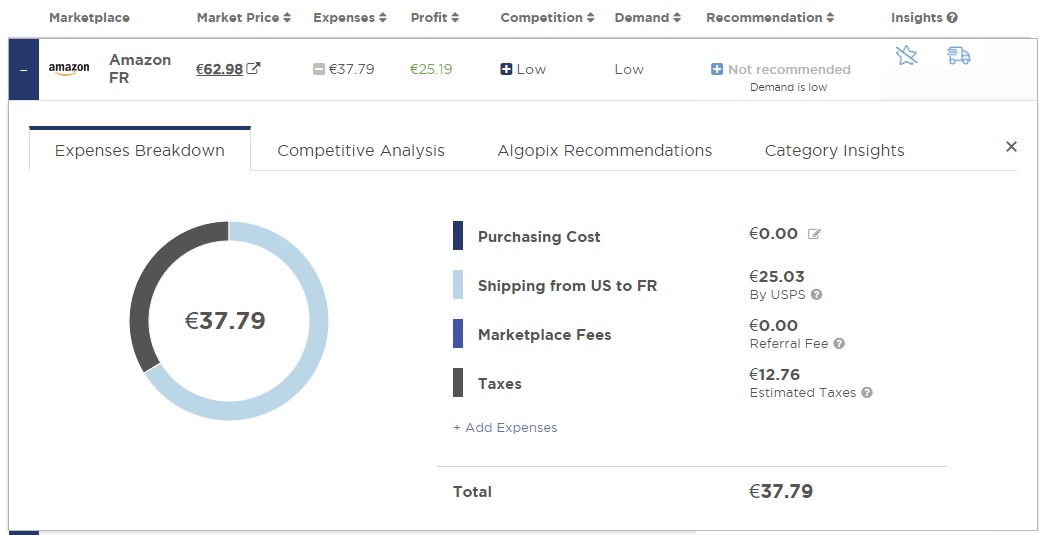
Beneath that table, you’ll see a summary of the product’s sales performance over the past 30 days, which will include the top-performing marketplace with estimated units sold and revenue accumulated.
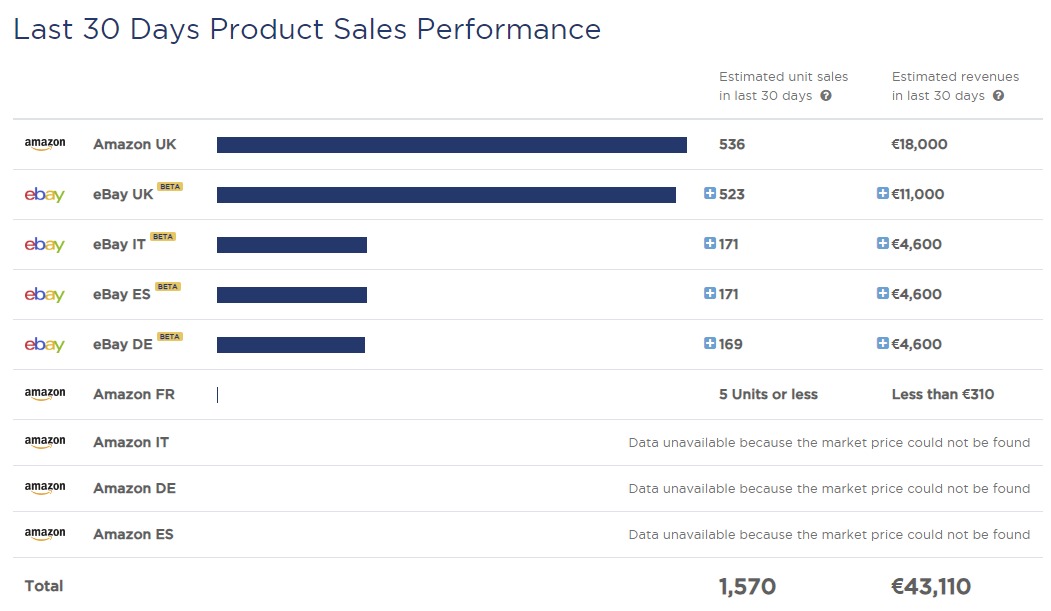
Clicking the + buttons on a particular marketplace in that table will reveal more details about its listings and you can see a more detailed breakdown of them by clicking ‘View Sales Breakdown’ in the bottom-right:
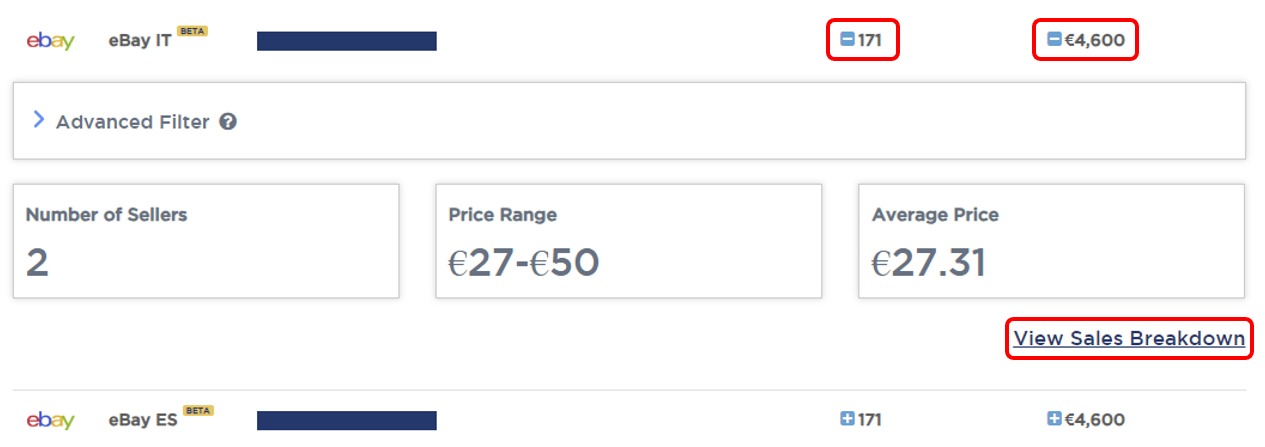
You’ll also get a rough idea of possible product sales on eBay and Amazon via the Sales Estimator algorithm here:

For your chosen product, you’ll get a range of sourcing opportunities according to your specified purchasing cost—this is a list of the closest found products available on Alibaba.com for sourcing and selling in your own markets.
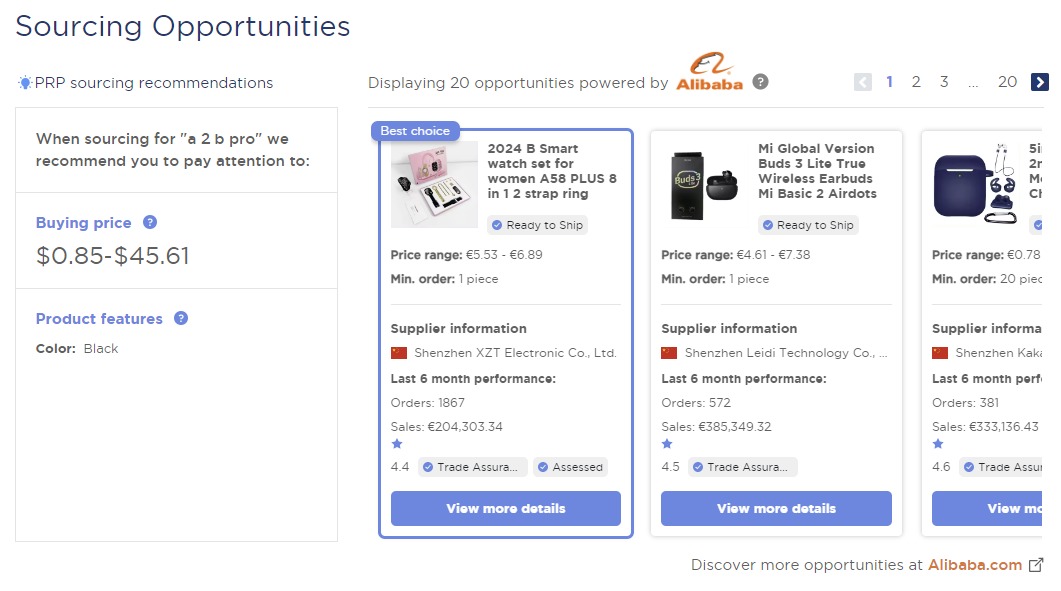
If you are researching a range of closely related products, you can pick any of the ‘Similar Items to Analyze’ listings at the bottom of your report to investigate further. Simply click the ‘Analyze Product’ button to repeat the process:
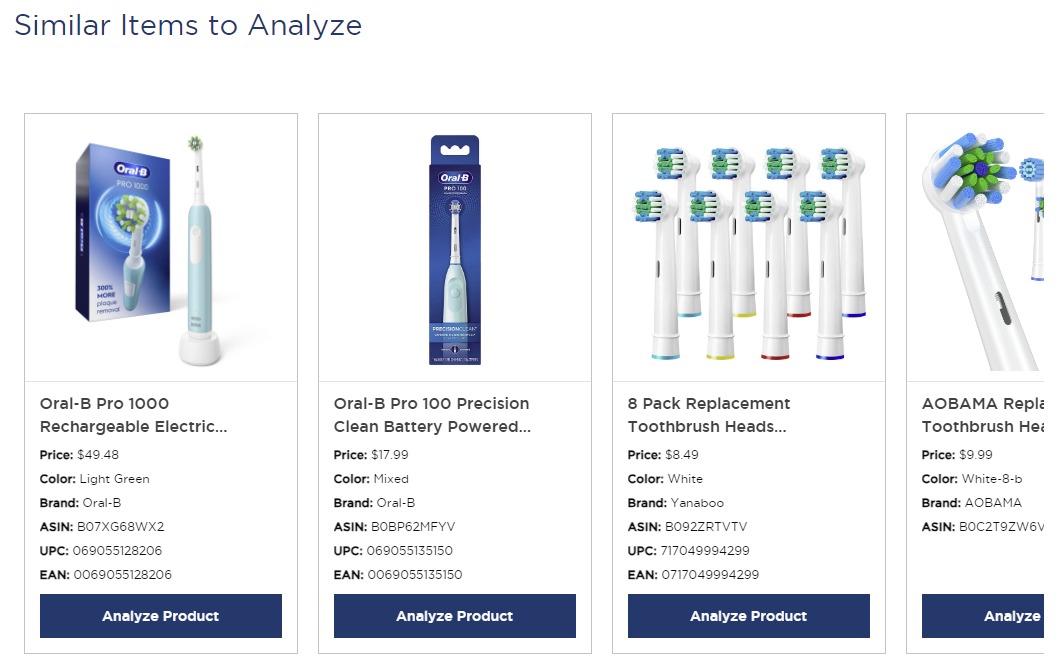
You can navigate to any of the above sections via the quick menu on the left-hand side:
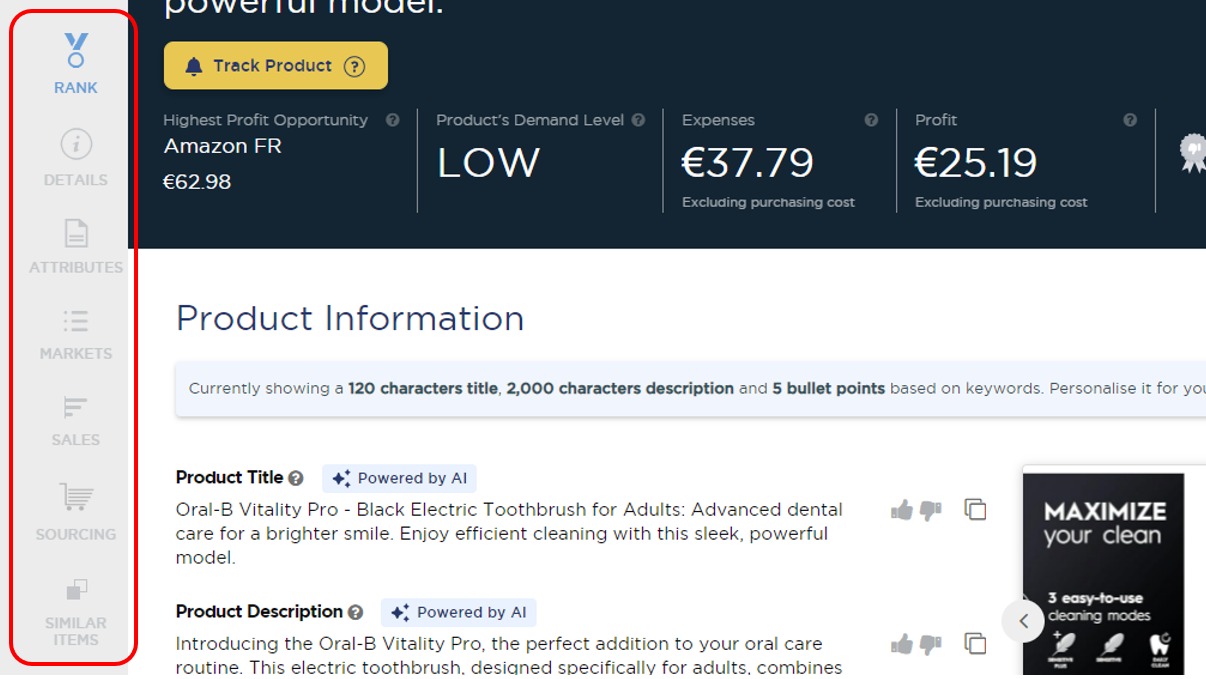
Multi Product Analysis
If, for example, you get a long list of products from a supplier and you want to quickly assess which ones might be worth pursuing, head to the ‘Multi Product Analysis’ tool.
Here, you can analyze up to 3,000 products at a time—simply drag and drop your CSV/Excel file into the white box or click ‘Upload File’ to select it from a folder on your computer. You can also download a file template in case you have your product list in a different format and you need to copy it over.

Let’s say, for example, you have a list of headphones on Amazon UK and you want to compare them in bulk. Your spreadsheet will need to include the identifiers (in this case, the ASINs) and the rounded-up costs for each product:

Drag and drop your file into the white box or upload it via the link—you’ll get a confirmation that it’s been uploaded in the form of a green tick box:

Once you’ve uploaded your file, you’ll need to select which columns to analyze and set your parameters.
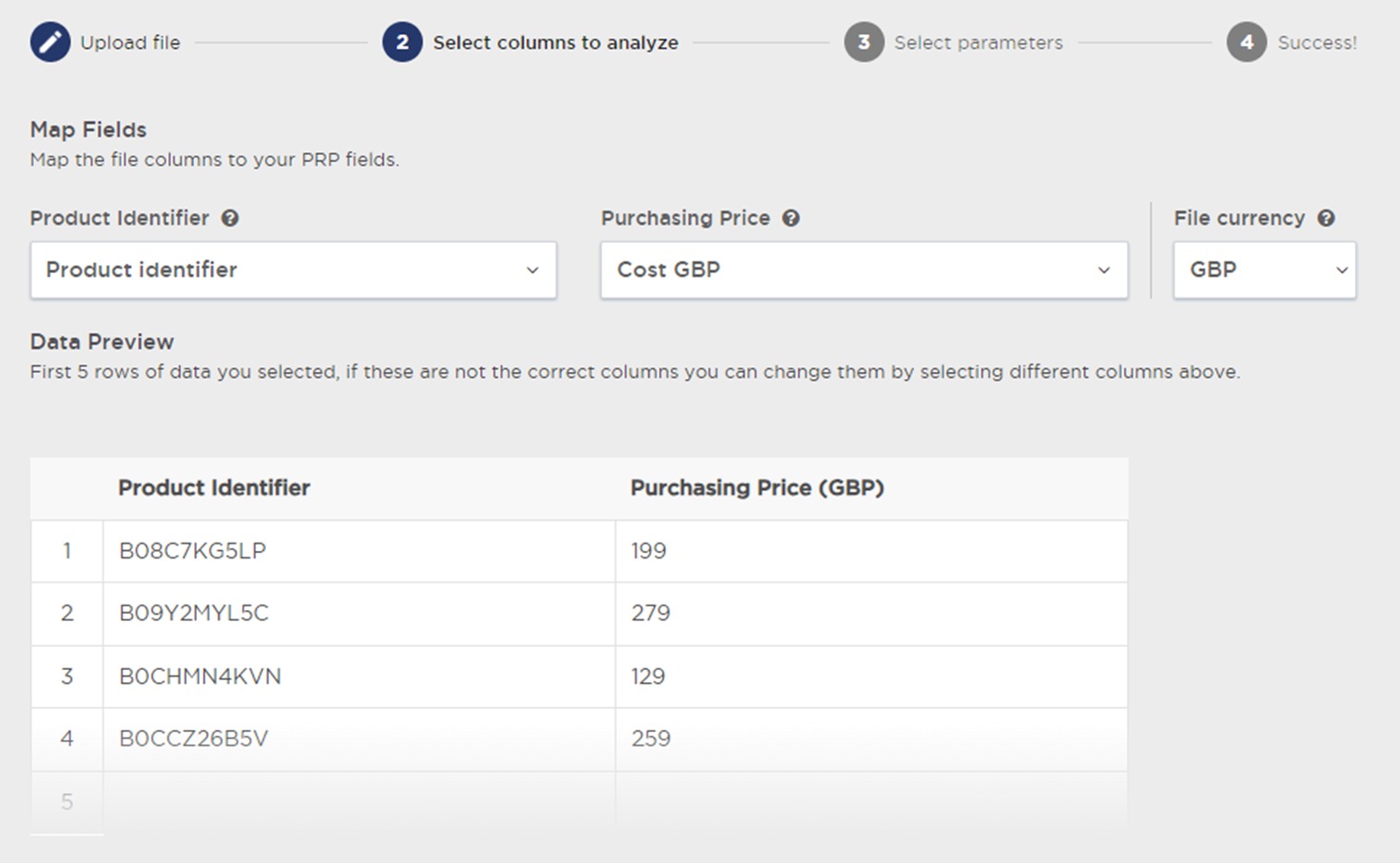
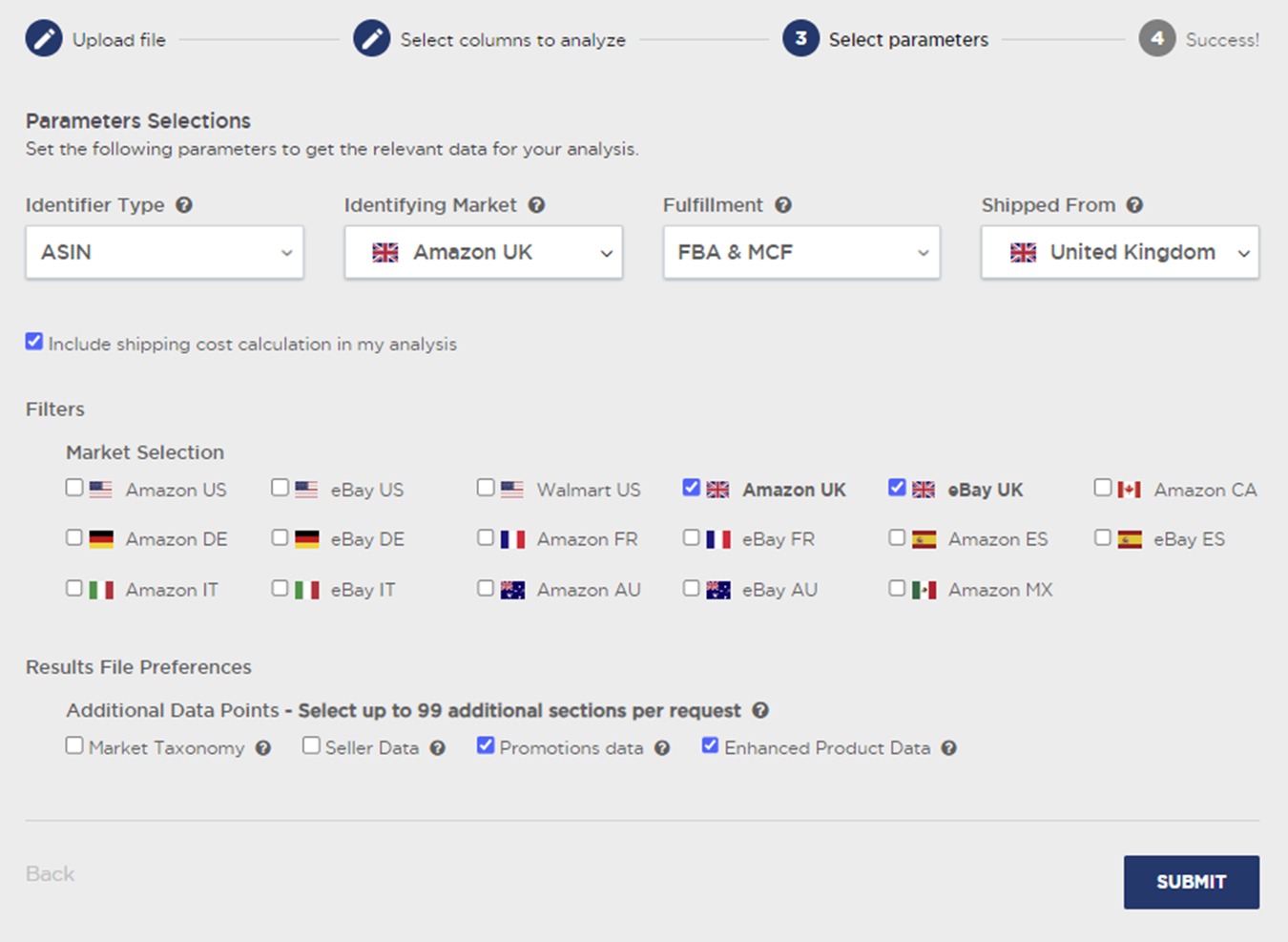
Click ‘Submit’ to complete the upload—you’ll get another confirmation and a notification to say that your insights are pending.
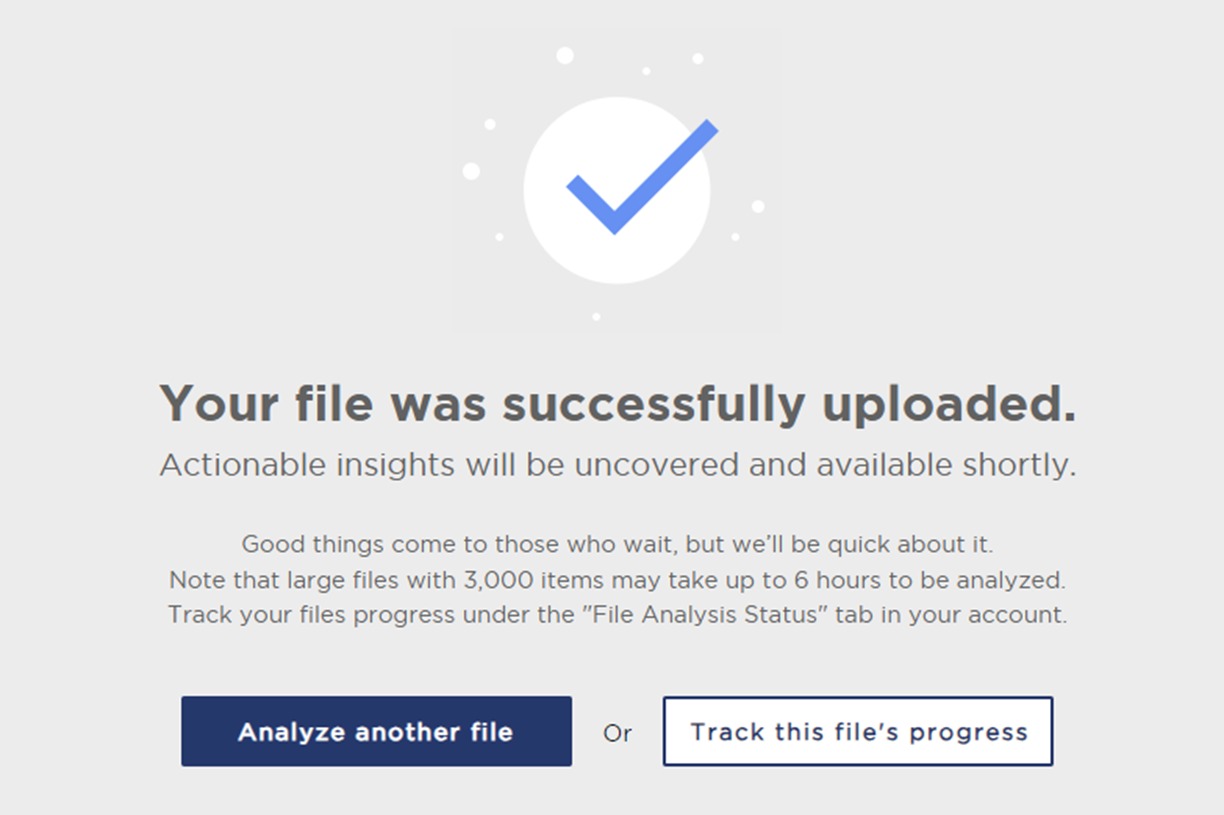
The status of your analysis can be found in the next tab, ‘Multi Product Analysis Status’:

When ready, you’ll need to download your file from the ‘Status’ column to start analyzing the products. The app will keep your analysis history and results for 12 months.
This can be a super efficient way to perform a bulk analysis on thousands of products at once to see which ones are recommended for your business. You can use it to analyze supplier price lists, optimize your inventory decisions and ultimately reduce costs and risks when you know what to source and sell.
Store Analysis
You’ll also find the ‘Store Analysis’ function under the ‘Analyze’ category of the ‘Solutions’ dropdown menu.

This feature allows you to analyze a specific store on Amazon, retrieving a list of everything it sells so you can assess top-selling products and compare them to your own inventory.
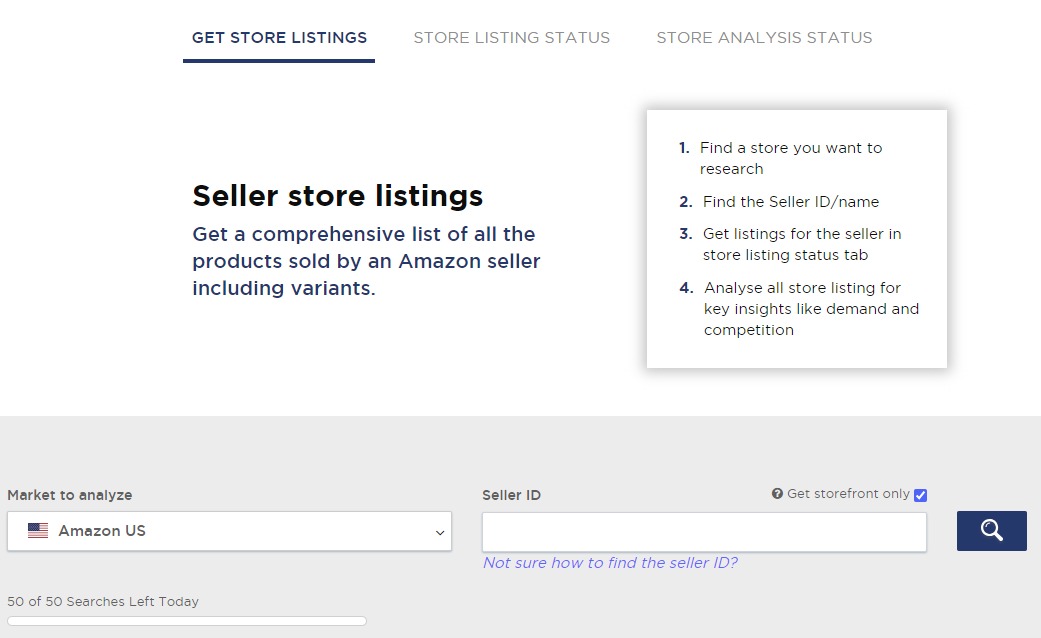
To find a store, copy and paste its seller ID into the box provided—you’ll usually see this in a product URL after ‘seller=’ or a store URL after ‘me=’, but there is also a help box beneath ‘Seller ID’ in the ‘Store Analysis’ tool to help you locate it. Click ‘Not sure how to find the seller ID?’ to find out more:
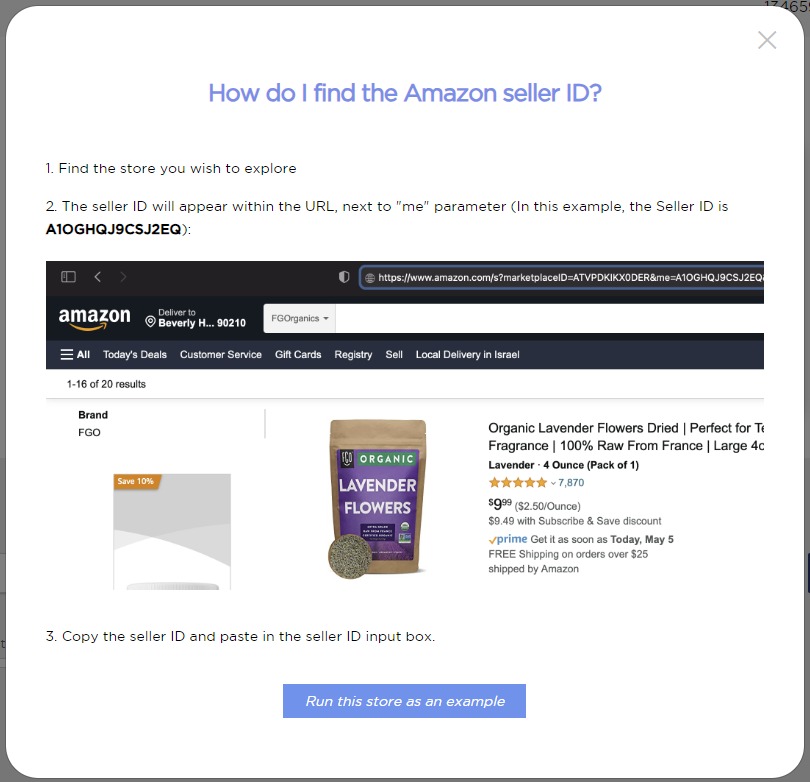
If you want a more comprehensive list of products beyond the seller’s Amazon storefront, which includes up to 2,400 products, uncheck the box above the ‘Seller ID’ form before searching:
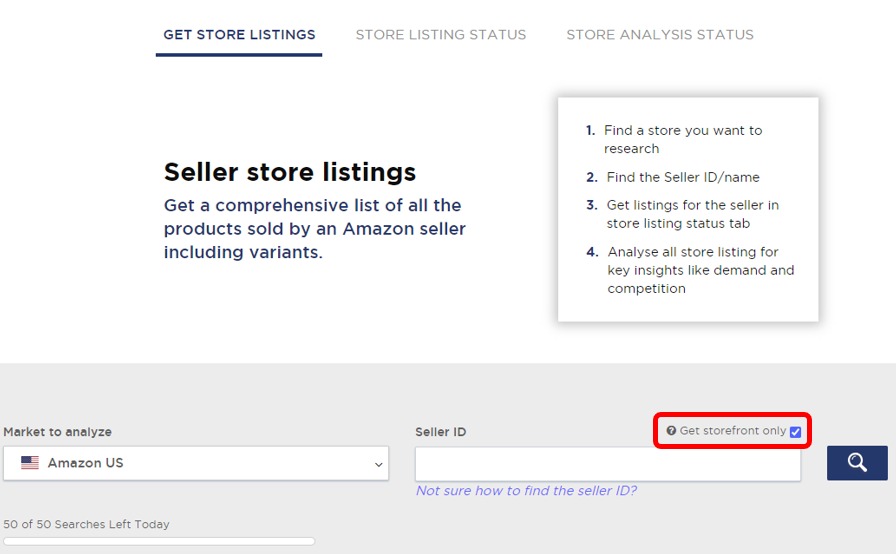
When you’re ready, click the magnifying glass icon to start collecting the store’s listings for analysis in the next tab, namely ‘Store Listing Status’:
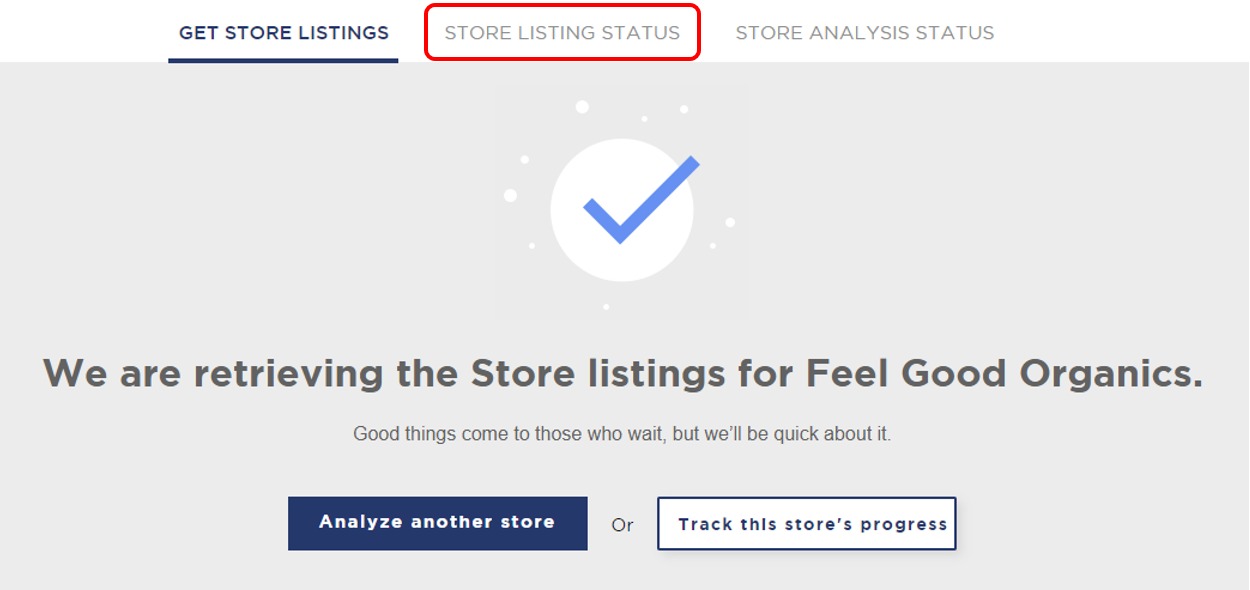
Here, you’ll find a list of the products in that store—you can toggle it up and down using the arrow and dive into individual products by clicking the ‘Analyze Product’ button.
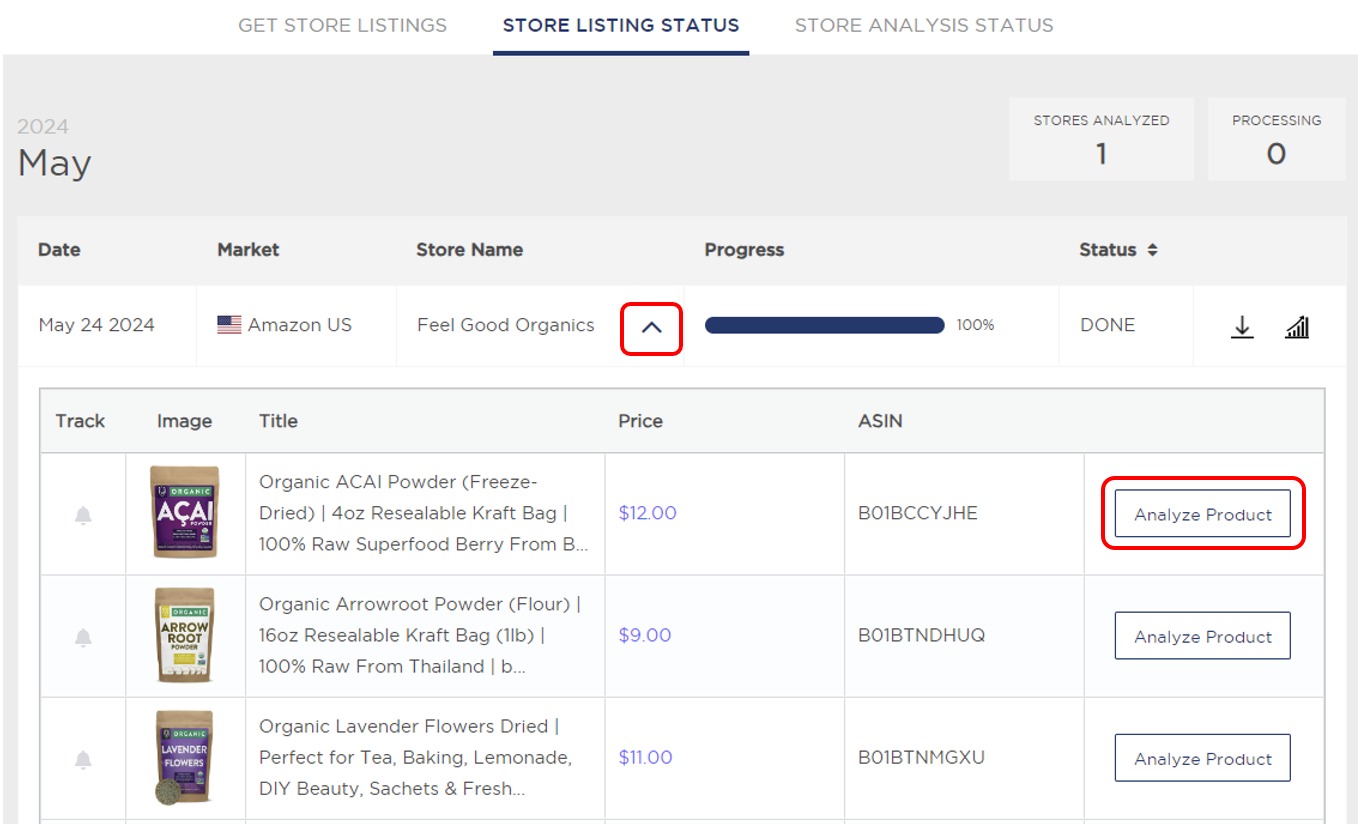
To get deeper store insights, click the ‘graph’ button in the ‘Status’ column and select your ‘Store Analysis Parameters’:
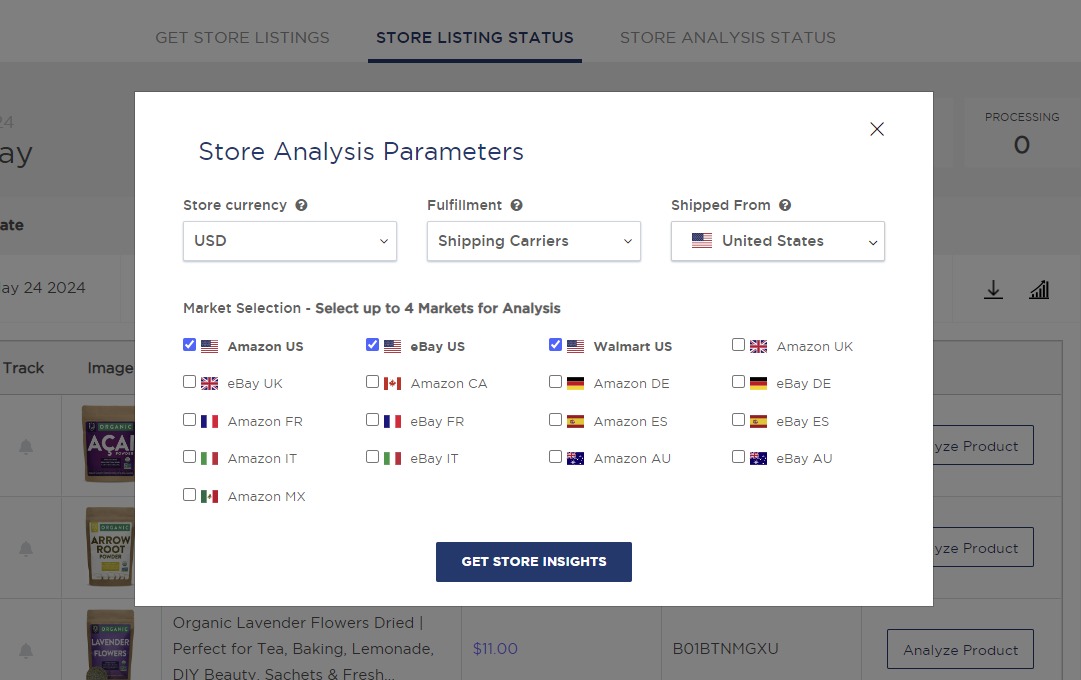
You should then get a status box to confirm that the analysis is underway and you can navigate to the ‘Store Analysis Status’ tab by clicking ‘here’ or from the main navigation bar.
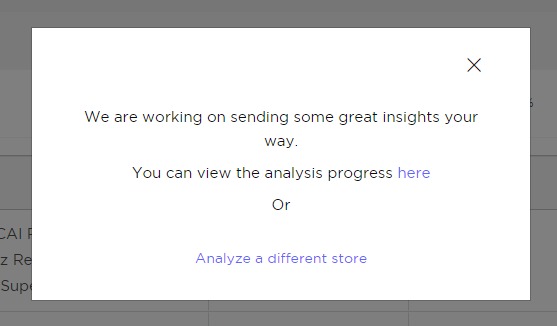

The length of this process depends on how many products the given store has in its inventory, ranging from a few seconds to a maximum of 120 minutes. You can cancel the analysis by clicking the red ‘x’ in the ‘Status’ column or wait until it’s complete before downloading the CSV file from the same place:

This tool enables a powerful form of market analysis, giving you a competitive edge when it comes to product comparisons, gap analyses and growth opportunities.
Sales Estimator
The ‘Sales Estimator’ tool gives you accurate product performance data for Amazon US products, including sales, GMV and units sold.
To calculate sales, you need to choose the category and enter the Best Sellers Rank (BSR) from the Product Information section on an Amazon product listing. For this example, we’ll use a BSR of 24 in the Patio, Lawn & Garden category (Amazon US). Click ‘Calculate Sales’ to get an estimate of the number of units sold per month for that product:
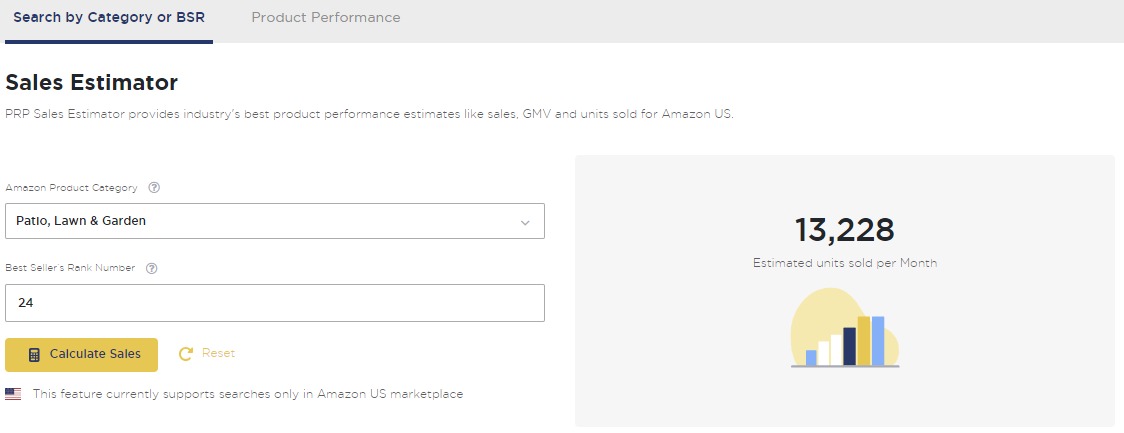
To search for a specific product, head to the ‘Product Performance’ tab and paste the ASIN into the box (the ASIN can also be found in the Product Information section of an Amazon product listing or in the URL).
Click ‘Analyze’ to retrieve product sales information and, if required, set your date range (up to 90 days) using the dropdown menu at the top-right of the graph:
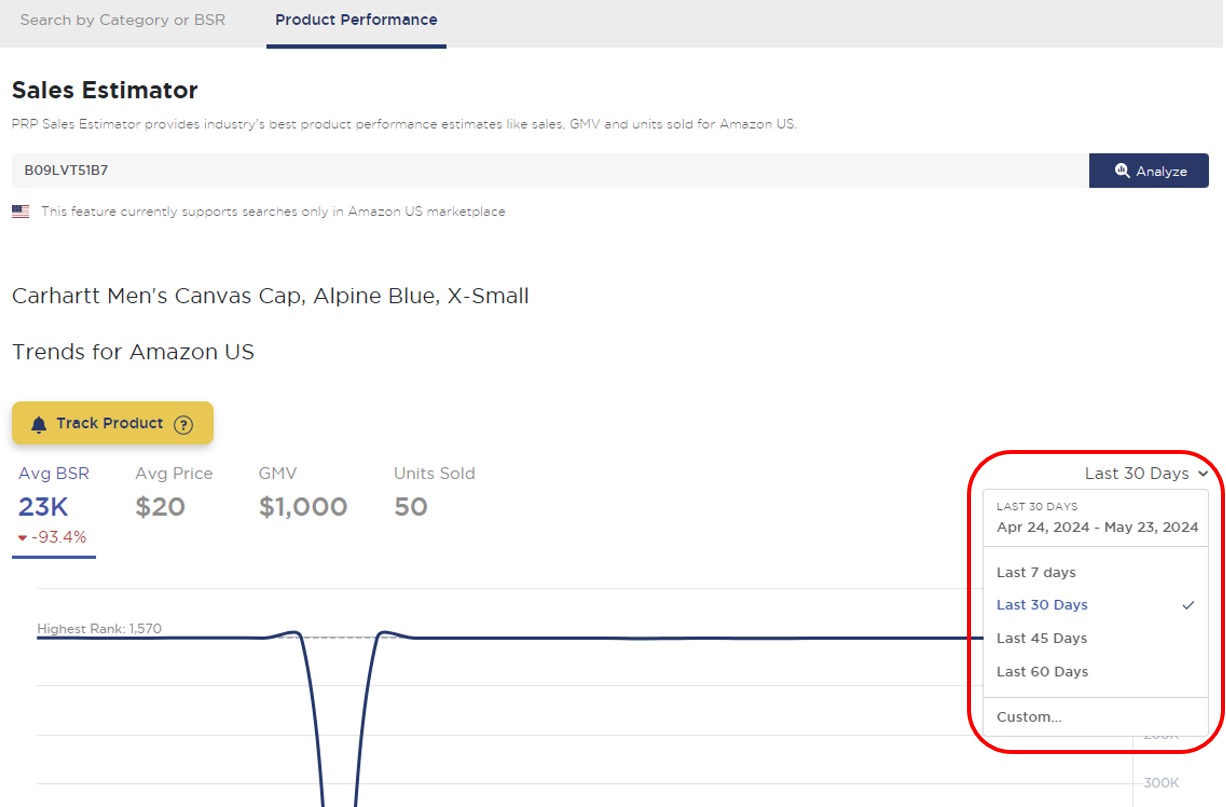
This feature works on a proprietary sales estimation algorithm that takes into account the actual sales and ranking histories of various products in a category and then estimates sales for other products depending on their rank and category.
Viewing such sales trends over time can be an extremely useful way of assessing the viability of individual products for your own for Amazon US inventory.
Identify By Keywords
You can discover new products by searching with brand names or descriptive keywords in the ‘Identify By Keywords’ feature of Product Research Pulse.
Simply add your search term to the box, select your market to analyze and click the magnifying glass to get started.
You’ll be presented with a list of products the tool found in its database, which you can then export as a CSV file to perform a bulk analysis in the ‘Multi Product Analysis’ feature or explore and analyze products of interest individually.
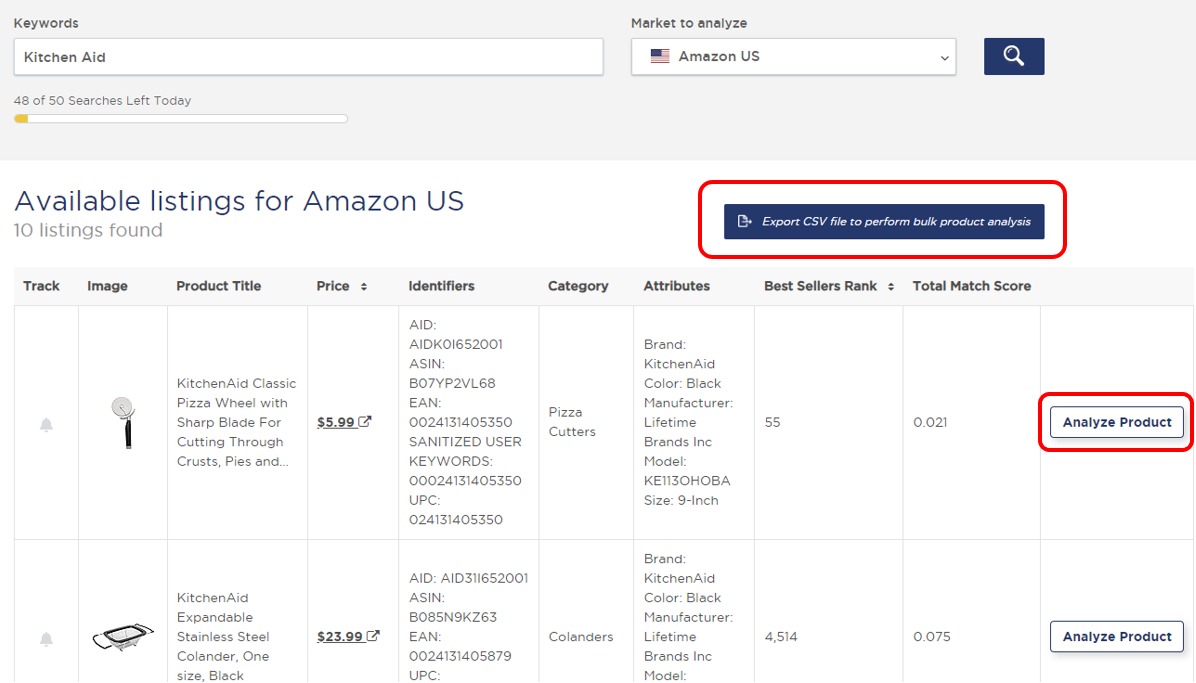
You can also sort the table by price or BSR using the arrows:

If some of the columns or cells are empty, it may be because the tool hasn’t yet found the information or that it doesn’t exist in its database.
Product Matching
The ‘Product Matching’ feature allows you to find the closest matching products to the set of criteria in your CSV file.
You can upload the CSV file by dragging and dropping it into the white box or locating it on your computer via the ‘Upload File’ button.

You may find that the result contains multiple columns of the same name or similar—this is because the tool adds the details of matching products found by the algorithm to the existing criteria in your spreadsheet. This data can be used to enrich your catalog with information that may have previously been missing from your products.
You have a daily limit of 30,000 searches within this feature.
Identifier Converter
One of the unique and most useful features of Product Research Pulse is the ‘Identifier Converter,’ which allows you to get any GTIN from product ID numbers, such as UPCs, EANs, ISBNs and ASINs.
The tool has a built-in database of GTIN mappings that gets refreshed twice a year, plus additional integrations with GS1 to validate GTINs.
With a monthly limit of 10,000 credits and three months of search history kept in your account, it’s easy to convert and refer back to identifiers for use across various channels.
To get started in the ‘Bulk Converter,’ simply drag and drop a CSV file into the white box or click ‘Upload File’ to locate it on your computer. You can also download a file template if you don’t already have one.
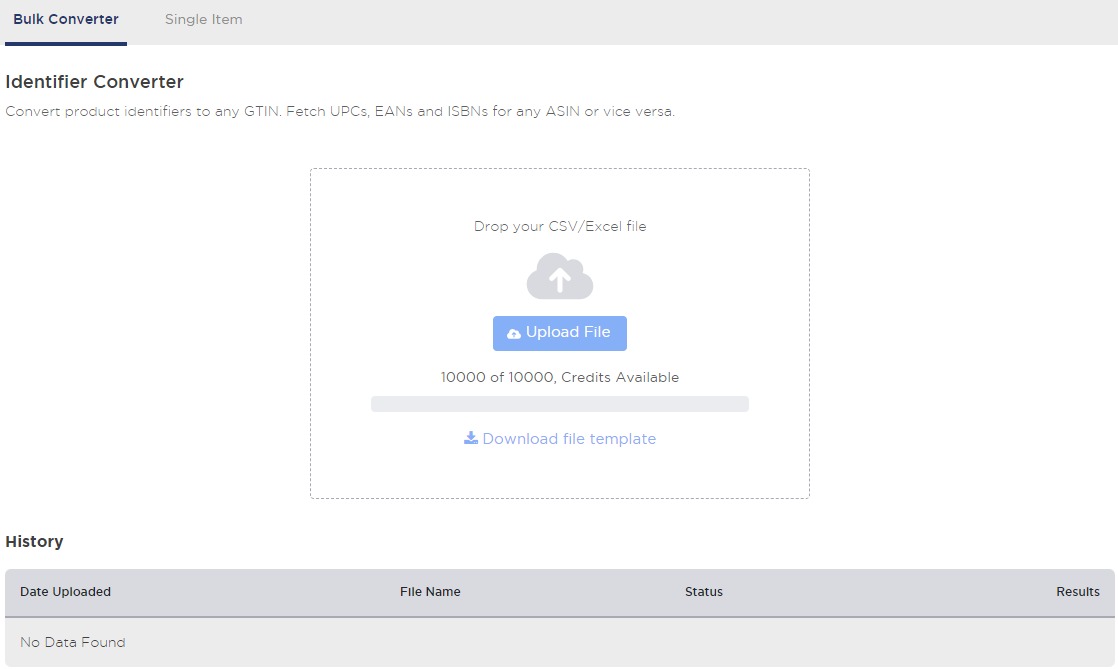
To convert a GTIN for a specific product, you can use the ‘Single Item’ converter tool if you have the GTIN to hand. Pick a GTIN type from the first dropdown menu—ASIN, UPC or EAN—and enter the code into the box beneath. Take this Amazon product as an example:

Click ‘Convert’ to obtain corresponding ‘Best Match’ GTINs for the product and copy them straight to your clipboard using the ‘Copy’ icon beside them:
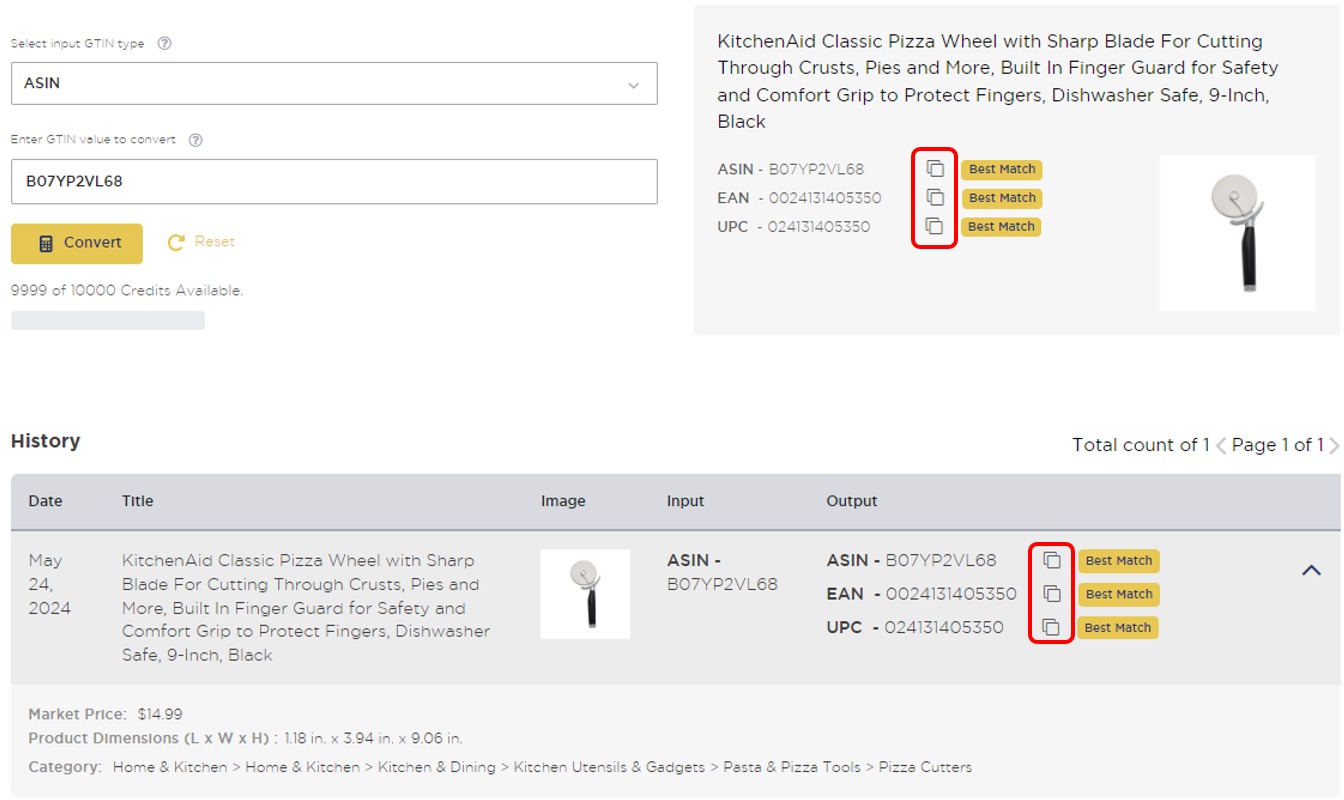
Every individual product search will use a credit from your monthly allowance, whether it’s done via the ‘Single Item’ converter or the ‘Bulk Converter.’ This resets every month at midnight on the 1st/from the date of your subscription.
Track Products
Throughout the app, you’ll notice a ‘Track Product’ button next to individual products, such as in the ‘Sales Estimator’ feature. This allows you to add items you want to monitor over time for changes in price, rank and monthly sales.
The product tracker starts monitoring from the moment you add a product to it and updates on a daily basis—it doesn’t provide historical data, but you can see this in the ‘Sales Estimator’ for the previous 90 days if you like.
It currently supports Amazon US only and allows you to track up to 1,000 products, which you can sort into up to 100 groups for ease of access. Your groups will be listed at the top of the page and you can add new ones using the yellow ‘New Group’ button, while you can add individual products to them via the blue ‘Add Products’ button.

Clicking to add a new product to a group will prompt you for a product identifier or keywords in a pop-up box—entering the details and clicking the magnifying glass will present you with possible matches to add to your list of tracked products.
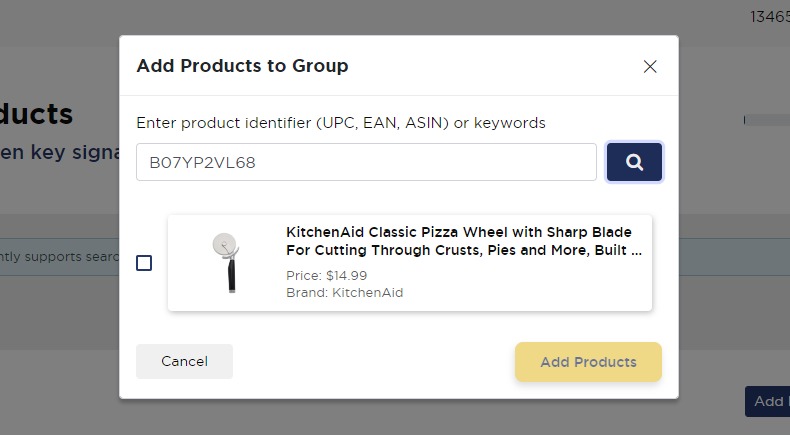
You can change the name of any group or delete it altogether by clicking the ‘Actions’ dropdown, while you can delete individual products by clicking the trash can icon or analyze the data collected by clicking the graph icon:

The tool may take up to a day to start collecting data, so some tracking information may be empty for a short while. Please allow 24 hours for data to appear here. Once it does, you can use it to assess average BSR, average price, GMV and units sold over a 90-day period.
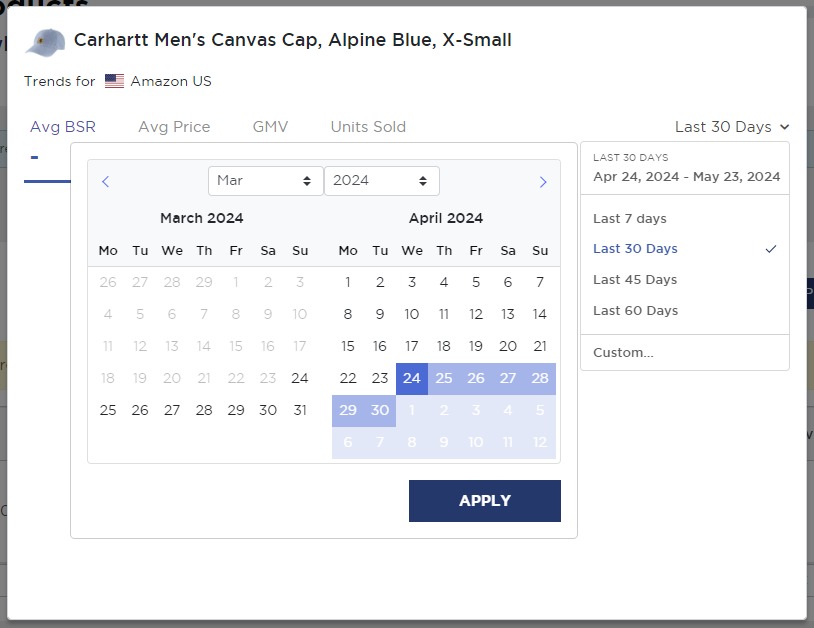
This feature can help you with the likes of market trend discovery so you can strategically pick your moments to enter profitable niches according to demand. It can also help with your pricing strategy if you’re monitoring similar products sold by your competitors.